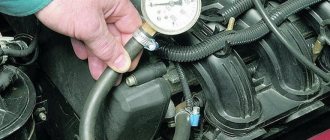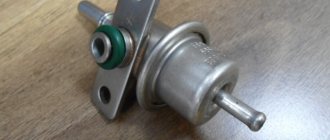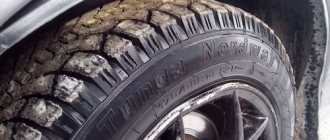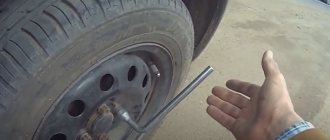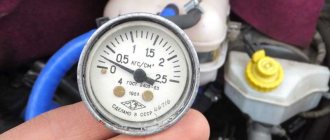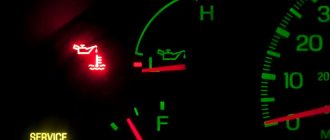Questions regarding what is the optimal pressure value in the engine are asked by a large number of car enthusiasts, regardless of the make of the car. After all, such discussions arise only because the standard instruments installed on the instrument panel do not represent dial or graphic indicators, but only a warning lamp. It signals extreme pressure, when the car may no longer be safe to use. Thus, monitoring the state of oil pressure in real time is simply unrealistic.
What oil pressure should be in the engine?
The operating oil pressure in each power plant is different; there is no single standard. At the same time, at operating speeds the pressure should be higher than at idle. This is logical: the faster the engine parts rotate, the more intense the lubrication.
Normal oil pressure in a VAZ 2103 engine
Let's look at the numbers using popular motors as an example:
- 16-valve engines of front-wheel drive VAZs: at idle speed no more than 1 bar, at 4-5 thousand revolutions it reaches 6 bar;
- 1.4 l. Chevrolet Lacetti engine: at idle speed no more than 0.7 bar, at 3.5 thousand revolutions it reaches 3 bar;
- Typical Mercedes diesel engine: 0.3 bar at idle, 3.5 bar at operating speed.
What affects engine pressure readings?
- engine displacement;
- number of cylinders;
- timing system: 2, 3, 4 valves per cylinder;
- amount of oil to be filled;
- ICE type: turbocharged or aspirated;
- fuel type: gasoline, diesel;
- cylinder arrangement: in-line, V (W) shaped, opposed.
Indicators of normal oil pressure in various modes are available in the repair and routine maintenance instructions for a specific car model.
Important: These numbers can only be correct if the engine components are in good working order (oil pump, filter). Of course, the engine oil itself must meet the vehicle manufacturer’s tolerances.
It is especially important that the oil viscosity meets the standard specified for the engine and weather conditions. At operating speeds (using the example of a 2.0-liter four-cylinder engine), the pump pumps about 30 liters of oil per minute.
The correct pressure cannot be applied if the lubricant is too thick or thin.
Diagnostics of the lubrication system
Modern engines are equipped with sensors that are located in different parts. During operation, the driver does not see information about which systems are operating and in what mode. Information comes to the control computer in the form of lighting individual indicators. They indicate the occurrence of certain errors in work.
If a certain failure occurs, the message “Check engine” appears, it signals that a failure is occurring. It is not advisable to use such messages.
When the engine wears out, such an inscription may indicate a decrease in pressure. Therefore, if the driver sees such a message, then diagnostics need to be carried out.
The motors have special connectors to which you can connect a laptop. Special programs for analyzing engine operation can be downloaded from the Internet. Each type of internal combustion engine has its own diagnostic programs.
Diagnostics are performed in the following sequence
- The connector is connected to the computer.
- The required program is activated.
- On a cold engine, the zero performance reading is determined.
- The engine starts.
- After warming up to normal thermal conditions, the program automatically reads information from sensors that were installed during manufacture.
- Among the information read, data on idle pressure is obtained.
- For some internal combustion engine models and software, you can check operation in engine acceleration or braking modes. Therefore, more complete information about the state of the systems is obtained.
- In most programs, in addition to the general condition, you can clarify how well the oil used corresponds to the engine operating conditions.
Based on the type of errors that are recorded after diagnostics, you can decide what is required for a particular motor. If the mileage is short, then most often normal operation is restored when consumables are replaced. The lubrication system will begin to show acceptable performance when new lubricant is added.
Reasons for decreased oil pressure
Many beginners have little idea of what low blood pressure can mean and what causes it. Let's look at the main ones.
- Lack of oil in the mechanism. It is necessary to check the oil level with the engine stopped. Add oil only of the same viscosity and brand that was before. We check the pressure.
- Increased oil filter resistance. This situation occurs after installing a filter that is intended for a different motor model.
- Problems with the oil pump. Malfunctions appear when there are certain contaminants, deposits on internal elements, and contamination of the oil filter. Also, the pump may simply wear out.
- Reducing valve jamming - here you will have to open the oil pan, remove the pump and find out the more precise cause of the problem.
- Large gaps between engine elements resulting from wear.
- Diluting the lubricant with fuel or special coolant. This provokes a decrease in oil viscosity and a subsequent decrease in pressure.
- Cylinder failure. In such a situation, the fuel does not burn in the cylinder, but gradually enters the crankcase, mixing with oil.
- Ventilation system failure. An excess volume of crankcase gases is formed, which will cause a decrease in pressure levels. The cause may be a faulty crankcase ventilation valve.
Emergency oil pressure sensor
The need to measure pressure
Oil pressure creates an oil film in the gap between the crankshaft journal and the journal bearing. When the pressure drops, this film disappears, resulting in oil starvation, friction between the parts of the unit increases, and the temperature rises. First of all, wear occurs on the crankshaft and other plain bearings. In the worst case scenario, the crankshaft may seize. Increased pressure also adversely affects engine performance. Seals, such as the front crankshaft oil seal, can be squeezed out, causing oil leakage, and again, leading to repairs.
The main reasons for the drop in lubricant pressure
If the warning light comes on, it means that the oil pressure has dropped to a critical point. The main reason for this is the failure of the oil pump. The pump stops circulating lubricant through the system, which leads to a sharp increase in temperature in the engine.
Be sure to watch the video:
Before determining the malfunction, you need to make sure that the pressure warning lamp is actually working (if the pressure gauge shows a sharp drop in pressure and the lamp does not light up). It must be unscrewed from the socket and inspected; if the filament has burned out, the lamp should be replaced. If it is intact, then you can apply voltage directly. It should be remembered that the voltage in a car electrical network is not the same as in an apartment or private house. Usually the operating voltage is written on the lamp base.
Also, the sensor itself, which shows what oil pressure is in the engine, may be broken. In this case, it must be removed from the engine and use a conventional hand pressure gauge.
If the light does not light, but the pressure gauge shows that the pressure is low, then you must first check the oil level. If there is insufficient lubricant, the pump simply will not be able to create the required pressure. The total amount of lubricating fluid in the system must be constantly maintained at the level required by the operating instructions. To do this, before each trip you need to take out the oil dipstick and look at what mark the level is. If it is minimal, then the oil must be added. But don’t get carried away; a high level of lubricant will lead to rapid overheating.
There is another very important reason why the drop in oil pressure in the system occurs gradually, but the result will be the warning light coming on. This is a fuel pump leak. After fuel enters the lubrication system, the lubricating fluid dilutes, which will lead to a loss of viscosity. The viscosity of the oil will deteriorate the faster the more the fuel pump leaks. To check the oil, you need to drain a small amount of it and determine “by nose”. The smell immediately makes it clear whether fuel is entering the lubrication system or not.
If the forced ventilation channel is clogged, exhaust gases and lubricant will enter the air system. This will also lead to a decrease in pressure in the oil system. High levels of exhaust and lubrication can significantly disrupt the operation of the engine, the overhaul of which will cost a considerable amount. Therefore, it is best to carry out control measurements as often as possible. The ideal option is to display the pressure gauge on the dashboard.
We recommend: Self-replacement of the coolant temperature sensor: 2 types and 7 signs of their malfunction
Leaving the oil filter for too long can also cause a drop in oil pressure. If the filter is bad and has not been changed for a long time, then it is best to immediately replace it with a new one. Set the next one not after the time specified in the instruction manual, but after 1000 km. You should not save money on the oil system and simply wash the filter in gasoline or diesel fuel. The oil filter is a consumable item and can only be replaced.
The main failure in the system is considered to be the failure of the oil pump. This is easy to determine - the lubricant does not circulate in the system and the engine quickly heats up. To repair the pump, you can purchase a repair kit, or simply replace it with a new one.
Danger of incorrect pressure
All car manuals will say that the pressure should be normal. But it is not always specified how this parameter is measured, what it depends on and how to raise it if it has dropped, or how to reduce it if it has risen. And what does this norm even mean? Let's figure it out.
As you can see, there are a lot of questions. It is unlikely that I will be able to give a detailed description of literally each of them. That's why we need your help. If you have ever worked with engines like FE-E, 6G72, YaMZ 236, 238, or the same ZMZ 409, it would be a good idea to leave your comment.
As for what the correct pressure should be, I’ll say it simpler first. It shouldn't be high or low. Average Because:
- High pressure. If it turns out to be too high, this will lead to the penetration of lubricant, that is, engine oil, into other components of the power unit. And this is not good, since this liquid should not go beyond the elements that need lubrication. The result is damage and expensive repairs;
- Low pressure. If it is low, there is nothing good about it either. The motor begins to wear out faster and overheats greatly due to a lack of lubrication. Details are literally destroyed. Engine jamming in such a situation is a matter of time.
As soon as the light on the dashboard that is responsible for the pressure in the engine lights up, you need to take action. And it doesn’t matter whether it’s low or high.
It is possible that the sensor simply did not work correctly, or the valve failed. We need to look for the cause and eliminate it.
Causes of a sharp drop in pressure
A sharp drop may occur in some cases:
- pallet breakdown. A similar phenomenon can occur when driving on roads with potholes and potholes. When there is a breakdown, the oil leaks out quite quickly. The lubrication system cannot operate. The “Check engine” indicator will immediately indicate a problem;
- pump failure. This phenomenon occurs quite rarely, but drivers can share that they have encountered a similar phenomenon. On modern vehicles, indications of errors in the lubrication system will appear quickly. On older cars you will have to listen to the engine (not the best option, but another is not always possible);
- Oil loss through leaks in the connection of internal combustion engine components can occur as a result of poor-quality assembly, as well as when using spare parts of inadequate quality. The oil does not flow out immediately. In parking lots, you can observe the formation of oil stains. Such phenomena should alert the car owner. You will have to constantly monitor the oil level using the dipstick readings. If necessary, you need to top up. However, this approach can be considered temporary. It is impossible to do without repairs.
Motor oils for worn-out internal combustion engines
In addition to new cars on the roads, there are those with mileage of several tens of thousands of kilometers. For cars manufactured in Western (Germany, France, Great Britain, Italy, Sweden, Czech Republic) and Eastern countries (South Korea, Japan, China), a mileage of 100 thousand km is not critical. The service life of modern vehicles often exceeds 200...300 thousand km. Domestic cars' mileage is also close to imported products. But for everyone, with use, the gaps still increase.
For vehicles with high mileage, lubricant manufacturers produce special oils. They contain additives that promote sealing in gaps. Working fluids, after being poured into the engine crankcase, ensure operation in conditions close to optimal.
What oil pressure should be in the engine?
One of the measures to monitor the condition of the engine is to periodically measure the oil pressure in it. Whether the oil light on the instrument panel is on or off – from time to time, you still need to check this parameter. You cannot absolutely rely on the fact that the sensor will definitely let you know about problems that have arisen in the engine, since the sensor itself may also malfunction.
At idle, it is considered normal when the oil pressure is around 2 bar, and at speeds over 5 thousand - from 4.5 to 6.5 bar. But these are average indicators, and the exact ones depend on the modification of the engine: its power, number of cylinders, valves. Again, it depends on the fuel used - gasoline or diesel. What oil pressure is acceptable for each specific engine, at what speeds to take measurements - all this is indicated in the technical documentation of the car. If the documents do not focus on engine speed, then measurements should be taken at idle.
To find out what oil pressure currently exists in your engine, you need to perform a simple check. To do this, you should:
- Warm up the engine to a temperature of at least 60 °C. It is necessary to measure the pressure at the operating temperature of the engine - only at this temperature does the oil heat up properly and acquire the fluidity necessary to lubricate the parts. On an insufficiently warmed up engine, the pressure gauge data will be incorrect.
- Stop the engine and disconnect the oil pressure sensor.
- Screw an adapter with a suitable thread into the sensor seat - it is included with the pressure gauge. Connect the pressure gauge hose to the adapter.
- Start the engine and measure the oil pressure. It is necessary to measure at different crankshaft rotation speeds (revolutions recommended in the documentation for measuring oil pressure). Record all pressure gauge readings as soon as its needle reaches a stable position.
- Stop the engine and let the oil pressure drop on its own, or you can force it to zero using the pressure release button located under the pressure gauge.
- Return the pressure sensor to its original place.
- Now you know what oil pressure is in the engine of your car, and what it should be - you look in the documentation and compare the numbers with the data obtained. Causes of low engine oil pressure
What does the indicator affect?
If in old engines the only task of motor oil was to prevent wear of parts, today the range of functions has increased significantly.
Now the viscous composition removes heat from hot components and performs the function of hydraulics in various car mechanisms:
- in hydraulic compensator valves;
- chain and belt tensioners;
- couplings and so on.
If the oil pressure in the engine is too low, oil starvation occurs, followed by accelerated engine wear. Malfunctions in the operation of the above hydraulic systems are also possible. All this inevitably leads to serious malfunctions and expensive repairs.
Oil starvation causes accelerated wear of spare parts.
For example, there are cases when the hydraulic tensioner of the timing chain fails. And subsequently, due to a collision between the piston and the valves, the engine may no longer be repairable. Requires purchasing a new one. This will bring many unplanned costs.
The vehicle dashboard is specially equipped with a lamp that indicates a decrease in the normal pressure level. In some cases, an exact indicator is indicated. You can measure the indicator yourself, but you will need a special device for checking the oil pressure in the engine - a pressure gauge.
Do not forget that insufficient and excessive engine oil pressure is different for each car and may differ from the accepted standards of another brand.
How to check the pressure in the system?
A warning light that indicates an emergency condition of oil pressure is absolutely necessary.
However, like all electrical appliances, it can burn out, its contacts can become unusable, and there are also a number of cases when its signals can be false. Therefore, checking the oil pressure should be carried out periodically.
For diagnostics, we will need a special pressure gauge to monitor oil pressure; if you don’t have one, we recommend purchasing one, fortunately, it is inexpensive and can always come in handy.
- We start the engine and wait for its temperature to rise to operating temperature, that is, 90°C.
- Next, we turn it off, find the oil pressure sensor, unscrew it and screw the pressure gauge into the vacant space.
It's easy enough to rip off the nut and then just unscrew it by hand.
- Then we start the engine and let it idle. We record the readings on the pressure gauge.
The pressure gauge readings are increasing.
- Then, using the gas pedal or throttle cable, we raise the engine speed to 5 thousand and also record the indicators.
Please note that if you have an on-board computer, it is possible to connect data coming from the fuel pressure sensor and then they will be accurately visible in digital form.
Engine oil operating pressure indicators
Any car operating manual indicates what operating oil pressure in the engine is required specifically for each engine. As for the 16-valve VAZ-2112 engine, the figures are equal:
- At idle speed: 2 BAR.
- At 5 thousand revolutions: from 4.5 to 6.5 BAR.
Normal values
What do you think creates lubricant pressure in an engine? Absolutely right, a special oil pump is responsible for this function. It operates from the crankshaft.
Pressure has two normal states.
- At idle engine speed. The engine idles, while the speed is at a low value. Normal pressure is taken to be around 2 bar, or 0.2 MPa. It depends on what units of measurement are used;
- On a hot one, that is, on a warm engine at high speeds. When measuring pressure in such situations in a diesel or gasoline engine, the pressure is usually between 4 and 7 bar. That is, from 0.4 to 0.7 MPa. And this is also considered the norm.
But I will say right away that the norm is a conditional concept. Much depends on what kind of car and specifically what engine you are dealing with.
Finding out the norm for your car is not difficult. For this there is such a thing as an instruction manual. Or any other sources of data about the technical characteristics of the car.
Finding the relevant information will not be difficult, and it does not matter what exactly you are exploiting:
- Lada Priora 16 valves;
- KAMAZ;
- VAZ 2114;
- Chevrolet Niva;
- VAZ 2106;
- Mercedes 190;
- Mazda 6;
- Lada Kalina 1.6 8 valves;
- VAZ 2112, etc.
If we take the same device, then in idle mode the norm is 2 bar. But raising the speed to 5000-5500 rpm, the norm rises to 4.5-6.5 bar. If it’s higher, then it’s already bad.
What does pressure depend on?
Also an important question. There are several main factors that directly influence the determination of the normal pressure level in the engine oil system.
Experts have different opinions on this matter. Some people think one position is correct, others think differently. But we can say that the following factors play a role:
- number of cylinders on the car;
- the number of valves used on the engine;
- number of horsepower;
- engine power;
- use of diesel fuel;
- use of gasoline;
- volume of the power unit;
- geometric dimensions of the motor;
- type of oil used, etc.
It happens that you are quietly driving your car, and suddenly the oil pressure control lamp lights up on the dashboard. That is, the operating condition is disrupted, and the warning light blinks, informing you of a potential threat.
There is a specific reason for this. You need to look for her. Perhaps the pressure did not disappear, but the sensor itself simply failed. The pressure is weak, or, on the contrary, increased for various reasons. But basically we are talking about a malfunction of the oil pump, or about depressurization of the system.
What is more dangerous for the engine, low oil level or insufficient pressure?
These two events are related to each other. Oil starvation (low level) is one of the causes of low blood pressure . The oil pump “grabs” air, which has a high compression ratio. As a result, the forces of the pump impeller (gears) are wasted on compressing air bubbles, instead of pumping up pressure.
What other reasons lead to loss of oil pressure?
- Viscosity mismatch according to SAE. Liquid that is too thick has difficulty passing through the pores of the oil filter. And increased fluidity leads to cavitation - the formation of air bubbles at normal oil levels.
Air bubbles in engine oil
- Engine overheating, or more precisely, incorrect operation of the cooling system. At abnormally high temperatures (outside SAE tolerances), the oil thins out. Next: see previous paragraph.
- Physical malfunction of the oil pump: Breakage of the injection unit (impeller, gears);
Violation of the tightness of the housing: there are cases of rubbing of the pump by the timing chain inside the crankcase.
- Foreign liquids getting into the engine oil: for example, antifreeze through a “broken” gasket. Consequences: liquefaction, formation of emulsion, foam, air bubbles.
- Severely dirty oil filter. Sometimes during routine maintenance, only the fluid is changed, but the filter continues to clog.
Helpful advice
Oil pressure is also affected by its viscosity. Do not use too thick oil for the winter. Firstly, it will make it difficult to cold start the engine. Secondly, it is possible that the pressure drops 20-30 percent below normal.
If you have a car with more than two hundred miles, you should not pour too thin oil (for example, 0W30). Yes, it makes it easier for the engine to start. But due to worn oil seals and gaskets, most of it will leak out. There are often cases when it took up to three liters of oil to top up. In this case, the best option is 10W40.
Emergency indication of engine oil pressure
At the moment, almost every car is equipped with an emergency indicator, which indicates a lack of pressure. It is popularly known as a “burning oil can.” If it fades out within 10-20 seconds after starting the engine, then you don’t have to worry. The oil filter is to blame here. A constant glow of the light indicates more serious problems - a breakdown of the pressure sensor, failure of the oil pump, etc.
Pay attention to the emergency indication. Ignoring problems can lead to major engine repairs. If the light comes on, quickly turn off the car and take a tow truck or tow truck https://volok-evakuator.ru/lotoshino.html to a good service station.
How to check oil pressure yourself?
The engine oil pressure is checked only when the engine is well warmed up and the operating temperature reaches 90°C. After warming up, the engine must be turned off and the oil pressure sensor removed from the oil line. A manual pressure gauge is installed in its seat. Next, start the engine again and measure the oil pressure at idle, be sure to write down or remember the readings. After this, add gas until the engine speed exceeds 5000 rpm and take the readings again. The operating manual will tell you which readings are optimal for the car. Each car should have different engine oil pressure, since this indicator is affected by the number of cylinders and their displacement. If the check shows underestimated figures, then you should take the car to a car service center and have the oil system diagnosed.
Filter
To clean the oil, a filter is installed in each engine. It looks like this:
Experts note that this element should be changed at every oil change. For gasoline engines this is 8-10 thousand kilometers, for diesel engines - 12. During this period of time, the filter accumulates a lot of dirt. These are waste products, small shavings, and other debris. Each filter has a bypass valve that serves to supply oil directly in the event of a clogged cleaning element. But it doesn't work correctly for everyone. As a result, the lubricant is retained inside the filter and reaches important areas under low pressure. You should not save on this element. Buy only original filters. This will significantly extend the life of the engine and prevent it from running on low oil pressure.
Why does the oil pressure light come on? The engine has 8 or 16 valves, also at idle
Perhaps a very burning question is about the oil pressure light; when it lights up, the driver understands that something bad has happened to the engine, but what? How to understand? Today I will try to collect all the cases in which it can light up, this appears on almost all engines, regardless of the number of valves, even if it is used
It will be 8 or 16. Often it can blink even at idle. In general, there are a lot of reasons, let's figure it out...
I want to warn you right away that you CANNOT ignore this sensor! It lights up only in emergency situations, and your intervention and attention is required. If you wait for some time, then you can simply “ruin” your unit, and then a major overhaul is not far away. So if the lamp lights up or starts blinking, we urgently look into it.
About oil pressure
Previously, almost all cars were equipped with a special “screen” where the pressure in the engine was indicated. The scale measured it in units such as - kgf/cm2. The higher the engine speed, the higher the pressure became; if it was not enough, a special lamp would light up, signaling possible malfunctions. Now on modern cars this “screen” has been removed, it has been gone for a long time! Well, if only on some UAZ, and then not always, only the lamp remains. But it is advisable to know normal pressure.
Normal pressure at idle (from 800 to 1000 rpm), approximately from 0.5 kgf/cm2. I would like to note that for many 16 valve engines it can be a little more, about 0.6 kgf/cm2. This is because they are more revving and their oil is thinner.
This pressure is measured by a special sensor; if the parameters deviate, it lights up a special lamp, which signals that not everything is in order with the engine. As a rule, if the pressure drops to 0.4 kgf/cm2, the lamp begins to blink or burn briefly. Which already signals to you that something is wrong here. But it’s not always a matter of pressure; there are banal reasons, just the driver’s faults.
Simple malfunctions - about “lubrication”
The very first and most common reason is insufficient amount of oil in the engine. Beginners neglect the level and do it in vain. It’s quite simple to determine - we pull out the oil dipstick and see if it’s dry, then we should sound the alarm - we MUST add it to the required level, the engine is experiencing “oil starvation”. Fortunately, now the sensor is triggered at a critical but acceptable level.
Second - not timely replacement! Some of us drive on oil for more than 20, or even 30,000 kilometers; it simply turns into mush, after which it is very difficult to wash the inside of the engine! Accordingly, if there is no liquid lubricant, the lamp will signal you about this; such behavior is simply unacceptable. Often the engine cannot be saved, this is especially true on loaded units, for example, on TURBO. So we set ourselves a rule: we MUST change the oil as prescribed by the dealer, and I would even change it even more often, for example, now that my warranty has expired, I change it after 10,000 km, instead of 15,000 recommended by the official dealer.
In 50% of cases, the indicator lights up precisely because of these reasons, so remember them, they are really important, if you follow these rules, then perhaps your sensor will never light up.
Moderate causes - maybe a sensor?
Here it is worth mentioning options from which any driver is not protected, that is, practically not to blame. SO:
1) The pressure sensor has failed, this is a trivial problem with CHEVROLET engines; if the engine is not warmed up, the oil simply “breaks through” the sensor, and it begins to “leak” - it does not show the correct data, even if your level is normal, it will constantly signal you. What to do - just change it! Many cars have this problem, and therefore in winter we warm up the engines at idle - a must! It manifested itself like this, here is the video.
2) Wrong oil! Rarely, but it happens. Now, however, all manufacturers indicate the tolerance standards that need to be poured into their motor (for example, 5W - 40, 5W - 30), however, there are those who “don’t understand” who can fill in a brand and tolerances that are not designed for your unit (for example, 0W - 20) , what's happening? Such oil is either very liquid, or, on the contrary, very thick, the pressure begins to jump from normal - the pressure lamp lights up! Therefore, we are not being “wise”, we are pouring what the doctor ordered. If you don’t know which one, go to the forums for your model, everything has already been written there a long time ago.
3) Antifreeze or antifreeze gets into the engine crankcase. Unfortunately, this is not uncommon - the gasket between the engine block and the head breaks, and the coolant simply flows into the oil. Accordingly, the lubricant loses its properties, becomes liquid and can no longer withstand the required pressure (that is, it drops below 0.4 kgf/cm2). This malfunction is easy to determine; your coolant level will constantly drop, and there will be no drops under the car anywhere. And the oil level is constantly rising! In general, you need to take urgent measures, otherwise the engine will “knock.”
These are reasons that already require intervention in the inside of the unit, but they are moderate in severity, some are the most complex.
Complex reasons - that the oil filter
Yes guys, as strange as it may sound, the root cause may be the oil filter, and this manifests itself very often.
1) Oil filter - if you change everything at an official station, then be sure that they will supply you with original spare parts. But there is no guarantee - when you do it yourself! As a rule, you buy non-original spare parts, which can often be counterfeit (assembled in handicraft factories in China), the key factor for you is the price, you can understand! But such filters simply cannot hold pressure, how does this manifest itself? A cold engine or one that has been standing for a long time - you try to start it, it starts and after the first few seconds after starting, maybe from 3 to 10, the pressure lamp comes on, you can hear the knocking of the hydraulic compensators, if you have them. The thing is that the oil filter must have a special valve (check valve) or washer (locking washer) that locks the oil when the engine is turned off, that is, it should not flow into the pan, but be in the system. This is true for normal manufacturers, but for “fake” ones, this is completely far from reality - as a result, the oil drains and the engine needs some time to pump it back into the system! This is very bad, there is increased wear of parts, especially at times of maximum load (in winter)! What to do - just change the filter, you need to find a normal one, otherwise we will simply reduce the resource of the unit.
2) Pump – there is a pump inside the engine that pumps our lubricant; if it fails or becomes clogged, then the oil supply also stops, or it comes with “strain” - we change it and clean the pump. You need to remove the pan, sometimes you have to disassemble half the engine.
3) High engine wear. If your unit has traveled a huge number of kilometers, for example, about 400 - 500,000 km, then it may have worn out spare parts such as crankshaft liners, oil scraper rings, etc. It’s just time to “capitalize” it, although it will most likely “smoke” blue smoke on you. The power will also drop, the consumption will increase, and it may be “ungodly triple”, even if the spark plugs have been cleaned. These are the causes of wear and tear, nothing can save it - it needs to be repaired.
Complex malfunctions, as a rule, appear even when the engine is running normally, that is, you started it, it works - but the lamp is on (this could also include a malfunction of the pressure sensor itself). You need to go to a service station and measure the pressure in the system, if it is categorically low - 0.2 - 0.3 kgf/cm2, then you need to disassemble the engine and look for the reason, perhaps the pump is simply blocked, or the filter is clogged, and much more.
REMEMBER - you cannot drive, especially over long distances, when your oil pressure light comes on, it is dangerous! Almost always this indicates complex engine malfunctions, so get to the service station quickly!
Pump
Despite its reliability, it can fail. This usually happens on engines with a mileage of 300 thousand kilometers. Over time, the mechanical part begins to jam. The oil is supplied under pressure, but it is not enough to form a normal lubricating film. The wedge is not the only problem that happens with this element. Oddly enough, the pump itself can also become clogged. This happens when there are chips in the oil. Where does it come from? This usually happens when the insides of the filter are destroyed. As a result, all dirty particles begin to penetrate through the channels in the engine, including onto the pump itself. Because of this, oil pressure drops. Note that in some places the thickness of the channels can be only a couple of millimeters.
